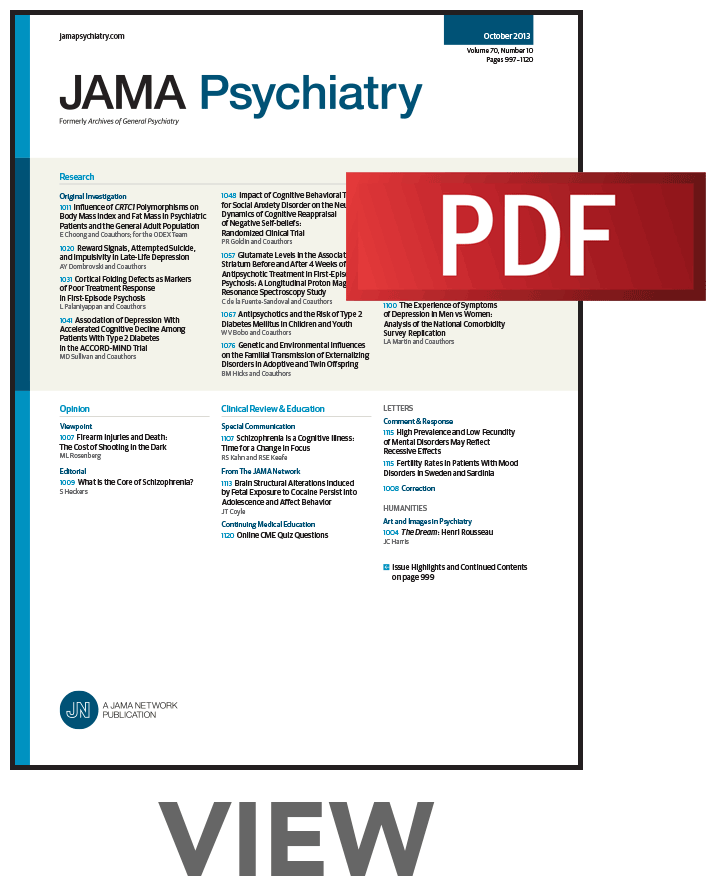Psychiatric Prognosis Following Index Suicide Attempts in Early Adolescents.
IF 17.1
1区 医学
Q1 PSYCHIATRY
引用次数: 0
Abstract
Importance The rates of suicide and suicide attempts are rising precipitously among early adolescents aged 10 to 14 years in the US. While suicide attempts in this age group are more common and associated with lower lethality than in older age groups, very little is known about these individuals' long-term social and psychiatric outcomes. Objectives To examine the adult outcomes of individuals making index suicide attempts that came to medical attention between the ages of 10 and 14 years. Design, Setting, and Participants This population-based cohort constitutes a subsample (n = 164) of a previously reported retrospective-prospective study examining individuals who made index suicide attempts during a 22-year period (1986-2007) in Olmsted County, Minnesota. Main Outcomes and Measures To collect outcome measures, the medical records of all individuals were queried until March 31, 2023, comprising up to 36 years of follow-up data after the index attempt. Measures included current social, psychiatric, and mortality outcomes as well as lifetime measures of psychiatric hospitalizations and repeat suicide attempts. K-means clustering generated adult groupings based on aggregates of psychiatric hospitalizations and repeat attempts. Multivariable logistic regression identified index attempt factors associated with poor adult outcomes. Results Of 164 individuals aged 10 to 14 years who made index attempts (128 [78.0%] female; mean [SD] age at index attempt, 13.7 [1.1] years), 3 (1.8%) died on the index attempt. In the follow-up period, no individuals died by suicide. K-means clustering generated a 2-group solution reflecting low (120 [80%]) and high (30 [20%]) rates of adult psychopathology. While a minority of the sample belonged to the high-rate group, characterized by multiple repeat attempts and hospitalizations, the majority had favorable social indicators and fewer reattempts and hospitalizations. Poor adult outcomes were associated with being male (odds ratio, 2.44; 95% CI, 1.00-5.80; P = .04) and having a psychiatric diagnosis prior to the index attempt (odds ratio, 3.27; 95% CI, 1.42-8.07; P = .007). Conclusions and Relevance In this sample of early adolescents with index suicide attempts followed into adulthood, all who died by suicide did so on the index attempt. While a small number of individuals went on to develop chronic severe psychopathology, the majority demonstrated little evidence of long-term impairment. Given this discrepancy, future studies should focus on using risk stratification after index attempts to direct postvention resources toward adolescents more susceptible to poor outcomes.青少年早期自杀未遂的精神病学预后。
在美国10到14岁的青少年中,自杀和企图自杀的比率正在急剧上升。虽然这个年龄组的自杀企图比老年人更常见,死亡率也更低,但对这些人的长期社会和精神后果知之甚少。目的探讨10 ~ 14岁间就诊的自杀未遂者的成人结局。设计、环境和参与者本以人群为基础的队列构成了先前报道的一项回顾性-前瞻性研究的子样本(n = 164),该研究调查了明尼苏达州奥姆斯特德县22年期间(1986-2007)有自杀企图的个体。主要结局和措施为了收集结局措施,查询了所有个体的医疗记录,直到2023年3月31日,包括在索引尝试后长达36年的随访数据。测量包括当前的社会、精神病学和死亡率结果,以及精神病学住院治疗和重复自杀企图的终身测量。K-means聚类基于精神病住院和重复尝试的总和生成成人分组。多变量逻辑回归确定了与成人预后不良相关的指数尝试因素。结果164例10 ~ 14岁患者中,女性128例(78.0%);平均[SD]年龄13.7[1.1]岁),3例(1.8%)死亡。在随访期间,没有人死于自杀。K-means聚类产生两组解决方案,反映低(120[80%])和高(30[20%])成人精神病理发生率。虽然少数样本属于高比率组,其特征是多次重复尝试和住院,但大多数人有良好的社会指标,很少再尝试和住院。成年后不良预后与男性相关(优势比,2.44;95% ci, 1.00-5.80;P = .04),并且在进行指数尝试之前有精神病学诊断(优势比,3.27;95% ci, 1.42-8.07;p = .007)。结论和相关性在这个早期有自杀企图的青少年样本中,所有死于自杀的人都是在自杀未遂时自杀的。虽然一小部分人继续发展为慢性严重精神病理,但大多数人几乎没有表现出长期损害的迹象。鉴于这一差异,未来的研究应侧重于在指数尝试后使用风险分层,将预防资源导向更容易出现不良结果的青少年。
本文章由计算机程序翻译,如有差异,请以英文原文为准。
求助全文
约1分钟内获得全文
求助全文
来源期刊

JAMA Psychiatry
PSYCHIATRY-
CiteScore
30.60
自引率
1.90%
发文量
233
期刊介绍:
JAMA Psychiatry is a global, peer-reviewed journal catering to clinicians, scholars, and research scientists in psychiatry, mental health, behavioral science, and related fields. The Archives of Neurology & Psychiatry originated in 1919, splitting into two journals in 1959: Archives of Neurology and Archives of General Psychiatry. In 2013, these evolved into JAMA Neurology and JAMA Psychiatry, respectively. JAMA Psychiatry is affiliated with the JAMA Network, a group of peer-reviewed medical and specialty publications.
 求助内容:
求助内容: 应助结果提醒方式:
应助结果提醒方式:


